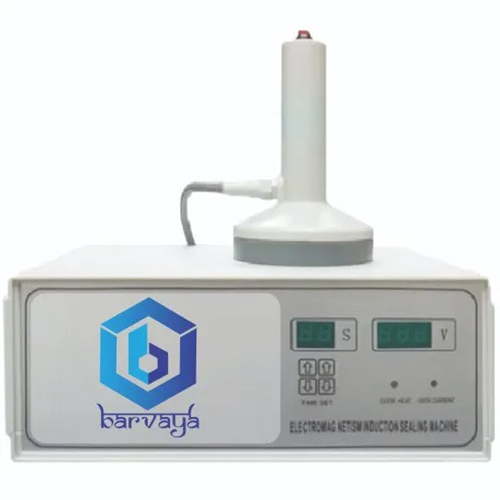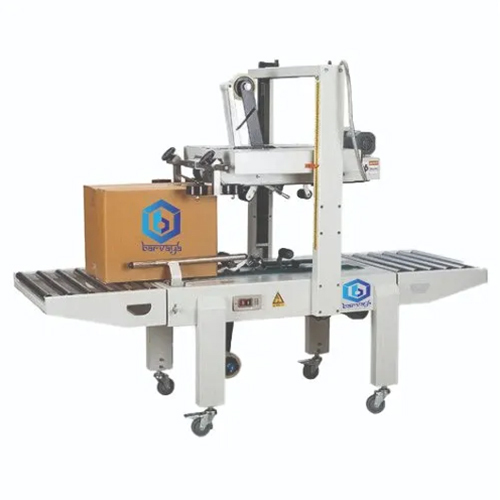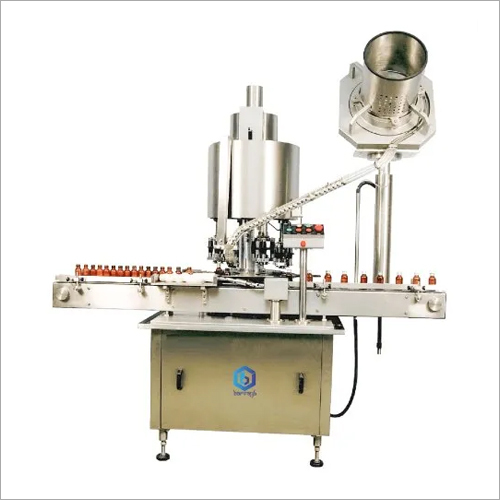Semi Automatic Induction Sealing Machine
75000 INR/Unit
Product Details:
- Condition New
- Power 3 Horsepower (HP)
- Color White
- Automation Grade Semi-Automatic
- Voltage 240 Volt (v)
- Type Induction Sealing Machine
- Application Industrial
- Click to View more
X
Semi Automatic Induction Sealing Machine Price And Quantity
- 1 Unit
- 75000 INR/Unit
Semi Automatic Induction Sealing Machine Product Specifications
- Induction Sealing Machine
- 240 Volt (v)
- Industrial
- White
- Semi-Automatic
- 3 Horsepower (HP)
- New
Product Description
A semi-automatic induction sealing machine is a packaging equipment used to seal containers, typically plastic or glass bottles, with an induction seal. Induction sealing is a method that involves applying a heat-activated seal onto the neck of a container using electromagnetic induction. This creates a hermetic seal, protecting the contents of the container from tampering, leakage, and contamination.
Here's how a semi-automatic induction sealing machine generally works:
1. Container Placement: The operator places the containers with their caps on the machine's conveyor belt or platform.
2. Induction Sealing Head: The machine is equipped with an induction sealing head that generates an electromagnetic field. This head is positioned above the containers.
3. Induction Foil: Each container cap has a liner made of a material that is compatible with induction sealing. This liner is often made of aluminum foil with a layer of heat-sealable polymer.
4. Sealing Process: When the container passes under the induction sealing head, the electromagnetic field heats up the foil liner. The heat causes the polymer layer to melt and adhere to the rim of the container's neck.
5. Cooling: After sealing, the polymer cools down and solidifies, creating a tight and secure seal on the container. This seal prevents any potential tampering or contamination.
6. Container Removal: Once sealed, the containers continue along the conveyor belt or platform, and the operator can remove them for further packaging or distribution.
Advantages of Semi Automatic Induction Sealing Machine:
1. Improved Efficiency: Semi-automatic machines streamline the sealing process by automating certain steps, reducing the reliance on manual labor. This leads to increased throughput and production efficiency compared to entirely manual sealing methods.
2. Consistent Sealing Quality: These machines provide consistent and reliable sealing quality. The heat generated by the induction sealing head is controlled, resulting in uniform and secure seals on containers. This helps maintain the integrity of the product and prevents leaks or contamination.
3. Reduced Labor Costs: While some manual involvement is required, the level of operator intervention is significantly lower compared to fully manual methods. This can help reduce labor costs and allow operators to focus on other tasks.
4. Tamper-Evident Seals: Induction sealing creates tamper-evident seals that are difficult to replicate or tamper with without leaving visible signs of interference. This enhances product safety and consumer trust.
5. Flexibility: Semi-automatic machines are versatile and can handle a range of container sizes and types as long as they are compatible with induction sealing. This flexibility allows businesses to adapt to different packaging needs.
6. Ease of Use: These machines are designed to be user-friendly, making them accessible even to operators with limited technical expertise. They typically have intuitive controls and simple setup procedures.
7. Reduced Human Error: While manual involvement is necessary for placing containers and possibly removing them after sealing, the critical sealing process itself is automated. This reduces the risk of human error in the sealing process.
8. Cost-Effective: Semi-automatic machines offer a middle ground between the higher cost of fully automated systems and the limitations of manual labor. They provide a cost-effective solution for businesses that need consistent sealing quality without a full automation setup.
9. Production Control: Semi-automatic machines allow operators to have more control over the sealing process. They can monitor the sealing quality, adjust settings, and intervene if needed, ensuring that the production line is running smoothly.
10. Adaptability: Businesses with varying production demands can benefit from semi-automatic machines, as they can be easily integrated into existing production lines or used as standalone units. This adaptability is particularly useful for businesses that experience fluctuations in demand.
FAQ:
Q. What is a semi-automatic induction sealing machine?
Ans: A semi-automatic induction sealing machine is a packaging equipment used to seal containers, typically bottles, with an induction seal. It automates the sealing process while requiring some manual intervention for container placement and removal.
Q. How does induction sealing work?
Ans: Induction sealing involves creating a hermetic seal on a container by using electromagnetic induction to heat a foil liner on the container's cap. The heat melts a polymer layer, bonding it to the container's neck and providing a secure seal.
Q. What types of containers can be sealed using these machines?
Ans: Semi-automatic induction sealing machines can be used to seal various types of containers, including plastic and glass bottles, jars, and containers with compatible cap materials.
Q. What are the advantages of using a semi-automatic induction sealing machine?
Ans: Advantages include improved efficiency, consistent sealing quality, reduced labor costs, tamper-evident seals, flexibility, ease of use, reduced human error, cost-effectiveness, production control, and adaptability.
Q. How is the sealing process controlled in a semi-automatic machine?
Ans: The sealing process is controlled by the machine's induction sealing head, which generates an electromagnetic field to heat the foil liner. Operators typically set parameters for heat intensity and timing based on the container type and sealing requirements.
Q. What is the role of the operator in the process?
Ans: Operators place containers on the machine's conveyor or platform, set sealing parameters, and may remove sealed containers. The critical sealing process itself is automated by the machine.
Q. Are semi-automatic machines easy to operate?
Ans: Yes, semi-automatic induction sealing machines are designed to be user-friendly. They often feature intuitive controls and simple setup procedures, making them accessible to operators with varying levels of technical expertise.
Q. Can these machines handle different container sizes?
Ans: Yes, semi-automatic machines are versatile and can handle a range of container sizes and types as long as they are compatible with induction sealing.
Q. What industries use semi-automatic induction sealing machines?
Ans: Industries such as pharmaceuticals, food and beverage, cosmetics, and chemicals often use these machines to ensure product integrity, prevent tampering, and enhance packaging quality.
Q. How do semi-automatic machines compare to fully automatic ones?
Ans: Semi-automatic machines require more manual involvement for container placement and possibly removal. Fully automatic machines handle the entire process, from container feeding to sealing and removal, with minimal operator intervention.
Q. Can these machines be integrated into existing production lines?
Ans: Yes, semi-automatic machines can be integrated into existing production lines or used as standalone units, providing flexibility in adapting to different production needs.
Q. What maintenance is required for semi-automatic induction sealing machines?
Ans: Regular cleaning, inspection of components, and occasional calibration of heat settings may be necessary to ensure the machine's optimal performance.
Enter Buying Requirement Details

 English
English Spanish
Spanish French
French German
German Italian
Italian Chinese (Simplified)
Chinese (Simplified) Japanese
Japanese Korean
Korean Arabic
Arabic Portuguese
Portuguese



